Punjab State Board PSEB 10th Class Science Important Questions Chapter 8 How do Organisms Reproduce? Important Questions and Answers.
PSEB 10th Class Science Important Questions Chapter 8 How do Organisms Reproduce?
Long Answer Type Questions
Question 1.
What is the basic need of reproduction? How does variation arise?
Answer:
A basic event in reproduction is the creation of a DNA copy. DNA of nucleus of cell is the store house of information for making proteins and directing other biochemical reactions in the cell. The different proteins will eventually lead to different set ups, shapes, working, etc. of body. Cells use chemical reaction to build copies of their DNA. This creates two copies of the DNA in a reproducing cell, and they will need to be separated from each other.
DNA copying (DNA replication) is accompanied by the creation of an additional cellular apparatus, and then the DNA copies separate, each with its own cellular apparatus. Effectively, a cell divides to give rise to two cells.
Origin of Variation
The two cells formed are similar, but unlikely to be absolutely identical. No bio-chemical reaction is absolutely reliable. Therefore, it is only to be expected that the process of copying the DNA will have some variation each time. As a result, the DNA copies generated will be similar, but may not be identical to the original. Some of these variations might be so drastic that the new DNA copy cannot work with the cellular apparatus it inherits. This inbuilt tendency for variation during reproduction is the basis for evolution.
Question 2.
What are different types of asexual reproductions.
Or
Explain fission and fragmentation.
Or
What is budding?
Answer:
Types of Asexual Reproduction
- Binary fission
- Multiple fission
- Budding
- Fragmentation
- Regeneration
- Spore formation
- Vegetative propagation.
1. Binary Fission: It is the simplest method of asexual reproduction generally found in unicellular organisms like Amoeba, Paramecium, Euglena etc. Binary means two and fission means breaking, thus this process results in the formation of two daughter cells.
2. Multiple fission: It is a type of asexual reproduction in which nucleus undergoes repeated division before the cytoplasm breaks to form a number of uninucleate daughter cells. Each cell thus formed grows into a new individual. Multiple fission occurs in Plasmodium.
3. Budding: It is a common method of reproduction in Sponges and Hydra. In this process, the new individual develops from a small outgrowth on the surface of parent.
4. Fragmentation: If a filament of spirogyra breaks into fragments, each fragment grows into new indvidual.
5. Regeneration: It is a form of fission in which a parent individual divides into a number of parts, each of which regenerates the missing structures to form a whole organism. It occurs in flatworm, ribbon worms and annelids.
6. Spore formation: An individual produces spores which during favourable conditions give rise to new individuals, e.g. Mucor.
7. Vegetative propagation: A part of plant body other than reproductive organ gives rise to new individual plant, e.g. Rose stem cutting gives rise to new rose plant.
Question 3.
What is vegetative propagation? Name various types of vegetative propagation.
Answer:
Vegetative propagation. Vegetative propagation is defined as formation of two or more individuals from any vegetative part of plant. In this type of vegetative propagation new plants can be raised from roots or stems or leaves of a plant. It is a very rapid method.
It is of two types.
A. Natural vegetative propagation
- Natural vegetative propagation by roots in plants e.g. Radish, Dahlia.
- Natural vegetative propagation by stem e.g., ginger, potato, onion.
- Natural vegetative propagation by leaves e.g., Bryophyllum.
B. Artificial vegetative propagation.
- Cutting
- Grafting
- Layering
- Tissue Culture
![]()
Question 4.
Explain post-fertilization changes in plants.
Answer:
Post fertilization changes in a plant:
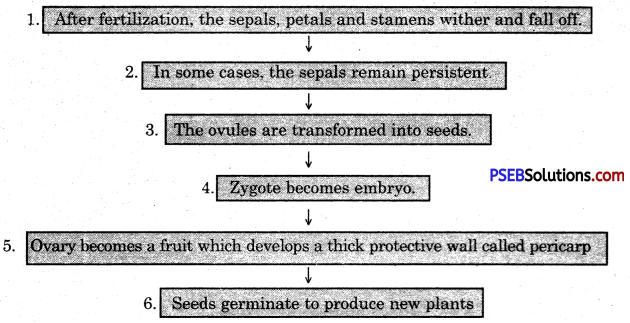
Question 5.
Describe the structure of a flower.
Or
With the help of a well labelled diagram, describe the parts of a flower.
Answer:
(a) V.S. of Flower:

1. Pedicel: It is stalk of the flower which raises it in the air to expose the flower to the pollinating agencies. Pedicel may bear two small leaf-like appendages called bracteoles.
2. Thalamus: The swollen or broad base or flat apex of pedicel that bears the floral leaves is called thalamus or torus.
3. Calyx or Sepals: The sepals are the outermost whorl of flower. They are collectively known as calyx. Calyx is green, appears first on the thalamus and is protective in function.
4. Corolla or Petals: It is the second whorl of flower. They are brightly coloured leaf-like flattened structures.
Petals may also be scented and have nectar glands at the base to attract pollinating agents i.e. insects.
5. Stamens or Androecium: Stamens are the male reproductive parts of the flower. Each stamen consists of a slender stalk filament and a knob-like terminal anther. Each anther has two anther lobes. Each anther lobe has two pollen chambers containing pollen grains.
6. Carpels or Gynaecium: The carpels represent the female parts of a flower. They are present on the central region of thalamus. They may be free or united. The free occurring unit of gynaecium is called pistil. Each pistil consists of three parts ovary, style and stigma.
Question 6.
With the help of simple sketches show’ the structure of seed and its germination.
Answer:
Structure of Seed
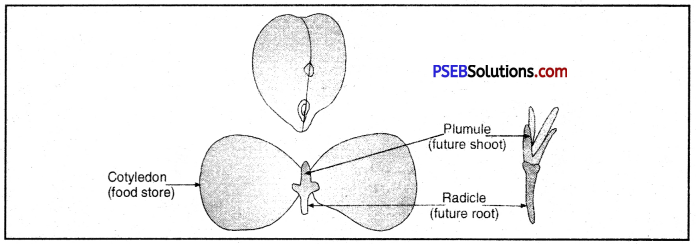
Structure of Seed
Question 7.
Draw a well labelled diagram of male reproductive system of man.
Answer:
Male reproductive system
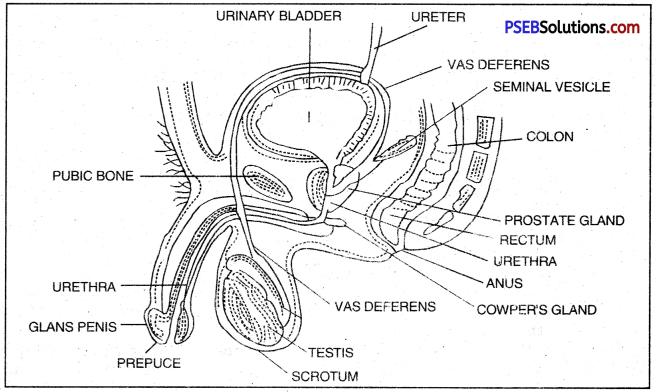
Reproductive organs of human male
Male reproductive system of human
- Pair of testes. These are primary sex organs. They produce male gametes, sperms. They also secrete hormones.
- Pair of vasa deferentia (Sing vas deferens). These are ducts which transfer sperms.
- Reproductive glands include pair of seminal vesicles, single prostate gland and pair of cowper’s gland. They form semen along with sperm.
- Copulatory organ (penis). It is involved in copulation.
Question 8.
Draw a well labelled diagram of reproductive organs of female human and explain.
Answer:
Female reproductive organs of human female
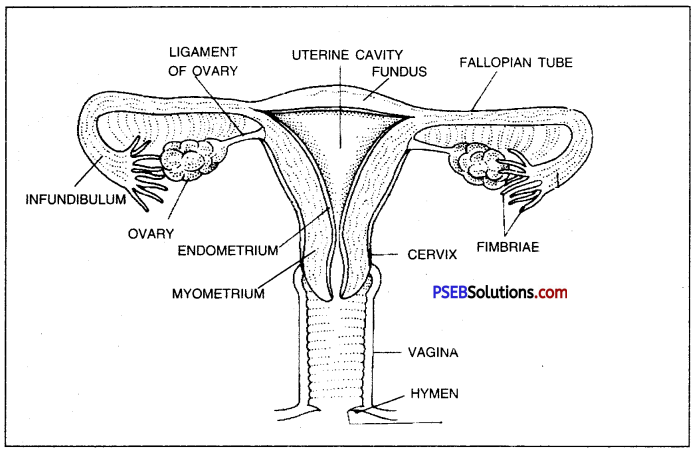
- Ovaries are primary sex organs which form germ cells or eggs.
- Ovaries also secrete hormones.
- A pair of fallopian tubes conduct eggs into uterus. It is also the site for fertilization.
- Uterus or womb is the site for development of embryo. It nurtures the growing embryo.
- Vagina receives semen during copulation.
![]()
Question 9.
Explain sexual reproduction in human beings.
Answer:
Sexual Reproduction in Human Beings
- The male gamete (sperm) is introduced inside the female genital tract (vagina) by the process of copulation or mating. It is termed insemination. Fertilisation occurs in the fallopian tube.
- Sperms are highly active and mobile which move up through cervix into the uterus and then pass into the fallopian tubes.
- Fallopian tube is the site of fertilization. Only one sperm fertilises the ovum to form a zygote.
- Fertilisation occurs only if copulation takes place during the ovulatory period of menstruation cycle.
- The embryonic development of the zygote starts immediately in the fallopian tube and pregnancy starts while menstruation stops.
- The embryo moves down to reach the uterus. The embedding of embryo in the thick inner lining of the uterus is called implantation.
- Then, a special tissue develops between the uterine wall and the embryo (foetus) called placenta, where the exchange of nutrients, oxygen and waste products take place.
- The time period from the development of foetus inside the uterus till birth is called gestation period.
- The act of giving birth to the fully developed foetus at the end of gestation period is termed as parturition.
- The development of the child inside the mother’s body takes approximately 280 days.
Question 10.
Give two reasons for avoiding frequent pregnancies by women.
Explain the following methods of contraception giving one example of each.
(i) Barrier method.
(ii) Chemical method.
(iii) Surgical method.
Answer:
Effect of frequent pregnancies.
- Adverse effect on health of women.
- Increase in population.
Methods of Contraception:
- Barrier methods: In Physical barriers such as condom, diaphragm and cervical caps avoid entry of sperms in the female genital tract during copulation.
- Chemical methods: Oral pills and vaginal pills are commonly used. Oral pills contain specific hormones.
- Surgical methods: It is vasectomy in male where a small portion of vas deferens is either removed or ligated (tied). In tubectomy in female small portion of fallopian tube is either removed or ligated.
Question 11.
Describe the various methods of birth control.
Answer:
The various methods of birth control are :
1. Physical barriers – Use of contraceptives. It means prevention of conception.
Following contraceptives are popular :
(а) Diaphragm. The vaginal diaphragm is a rubber cup stretches over a collapsible metal spring coil. It is designed to fit over the cervix, i.e. the mouth of uterus which prevents fertility or conception.
(b) Condom. The condom is a sheath of rubber which fits on the erect penis. It is put on the penis before it is introduced in the vagina during intercourse.
(c) Jellies, creams and foams. A number of different spermicidal jellies, creams and foams are available for use as contraceptive agents. These jellies, creams and foams are inserted into vagina five to fifteen minutes before the ejaculation takes place.
(d) Introduction of copper ‘T’ or loop in female uterus prevents the entry of sperms in uterus.
2. Chemical Methods: Oral Contraceptives. These are popularly known as “pills” and are combinations of synthetic sex hormones which suppress the production of ovum. These pills alter the ovulation cycle. ‘Mala’ and ‘Saheli’ are the two common pills.
3. Surgical methods. Sterilization. It is surgical technique by which the passage of sperms or ovum is discontinued. Both men and women can be sterilized without losing their ability to function sexually.
(а) Vasectomy: In men the sterilization procedure is called vasectomy,
(b) Tubectomy.: In woman part of fallopian tube is cut and tied off.
4. Medical termination of pregnancy (MTP). It is the cessation of pregnancy by surgery, suction or by other means.
5. Other measures.
(а) Abstinence: Abstaining from intercourse.
(b) Coitus interruptus: It involves the withdrawal of penis from the vagina just before ejaculation occurs.
(c) Zero ‘0’ method: It is a natural, effective and practical method where the woman has to find but herself the fertile and infertile period, by keeping a close watch on uterine discharge. The safest period to avoid pregnancy is from the beginning of mucus discharge to the next four days, after the discharge has stopped.
Short Answer Type Questions
Question 1.
What is reproduction? What are its basic types?
Answer:
Reproduction. All organisms born on this earth show characteristic life cycle, involving birth, growth, maturation, reproduction and death. Reproduction is one of the most important processes by which continuation of the species from one generation to another generation can take place. Older and aged organisms are replaced by new and younger organisms by reproduction.
There are two basic types of reproduction.
A. Asexual reproduction
B. Sexual reproduction
Question 2.
Define asexual and sexual reproduction.
Answer:
- Asexual Reproduction: It is a type of multiplication in which a young one is formed from a specialised or unspecialised part of a parent without the formation and fusion of sex cells, gametes.
- Sexual Reproduction: It is a type of reproduction which takes place by the formation and fusion of gametes.
It involves two major processes:
- Meiosis (reductional division) by which diploid sporophytic cells give rise to haploid gametes.
- Fertilization, which reconstitutes the sporophytic diploid generation through gametic fusion.
![]()
Question 3.
Differentiate asexual and sexual reproduction.
Answer:
Differences between asexual and sexual forms of reproduction
| Asexual Reproduction | Sexual Reproduction |
| 1. The process involves only one cell or one parent. | 1. This process involves two cells or gametes belonging to either the same or different parents. |
| 2. The whole body of the parent may act as a reproductive unit or it can be a single cell or a bud. | 2. The reproductive unit is called gamete which is unicellular and haploid. |
| 3. Only mitotic division takes place. | 3. Meiosis and fertilization are essential events. |
| 4. No formation of sex organs. | 4. Formation of sex organs is essential. |
Question 4.
Describe asexual reproduction in Amoeba.
Or
Explain the term fission as used in relation to reproduction.
Answer:
Binary fission in Amoeba. It is normal method of reproduction in Amoeba. It occurs under favourable conditions. The animal grows until it attains the maximum size and then divides by binary fission in every three or four days. The fission is completed in 15 to 20 minutes.

Binary Fission in Amoeba
Multiple fusion in Amoeba. Multiple fission inside the cyst has been described but not established. It has been suggested that sometimes, inside the cyst, the nucleus divides and surrounds itself with cytoplasm to form several small amoebulae. At the return of favourable conditions or on finding a favourable substrate, the cyst absorbs water and its walls burst. The amoebulae escape and soon each one grows into new amoeba.

Amoeba showing encystment and multiple fission.
Question 5.
Explain various steps of budding in yeast.
Answer:
Budding in yeast. Most of the common yeasts reproduce by budding. The process of budding occurs under normal conditions, when the yeast cells are growing in sugar solution. Saccharomyces usually reproduce by budding. In the process, each cell gives rise to one or more tiny outgrowths which gradually increase in size as large as the mother cell itself. Ultimately, it is cut off from the mother cells by a constriction at the base and can lead a separate existence.
The nucleus divides amitotically during budding and one daughter nucleus passes in the bud and the other remains in the mother cell. The nuclear membrane persists throughout the nuclear division. The budding may be repeated by the daughter cell while still attached to the parent cell, resulting in the formation of one or more chains and even sub-chains, called pseudomycelium. The cells ultimately become separated from one another and lead independent life.

Budding in Yeast Saccharomyces
Question 6.
Explain various steps of budding in Hydra.
Answer:
Budding. It is a common method of reproduction in Sponges and Hydra. In this process, the new individual develops from a small outgrowth on the surface of parent. The exogenous bud gets its nourishment from the parent till it gets the maturity. Then it breaks off from the parent body and develops into new individual. Sometimes, the buds do not separate off and form a chain of buds.
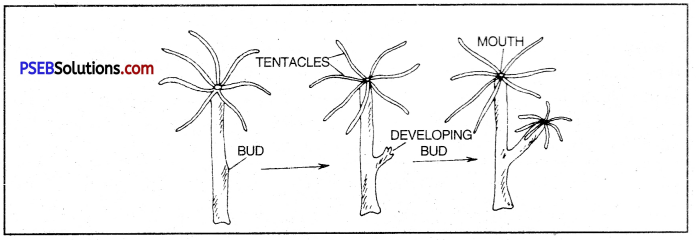
Budding in Hydra
Question 7.
Discuss spore formation in fungi.
Or
Illustrate spore formation in Rhizopus with a diagram.
Or
Write the benefit of spore reproduction.
Or
Illustrate spore formation in Rhizopus with a diagram.
Or
Write the benefit of spore reproduction.
Answer:
Spore formation: The spores in fungi vary in shape. Spores are usually unicellular, thick walled, spherical. The thick walls provide protection till these come in contact with other surface and can begin to grow. Sometimes the spores may be multicellular also. Sometimes the spores are produced endogenously in special sac-like asexual reproductive bodies called sporangia.
- Spores in such cases are called sporangiospores.
- Spores on falling on ground or substratum grow new hypha, e.g., Rhizopus, Mucor and Penicillium.
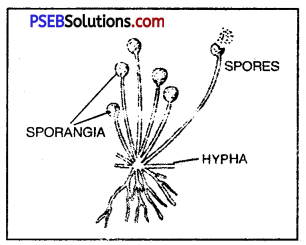
Spore formation in Rhizopus
Benefit:
- It is a fast method of reproduction.
- A very large number of spores produced ensure survival of organism.
Question 8.
What is regeneration? Describe regeneration in Planaria.
Or
Explain the term regeneration as used in relation to reproduction.
Answer:
Regeneration: The process of repair, replacement or revival of damaged or severed body parts or reconstruction of the whole body from a small fragment of it during the post-embryonic period of a multicellular organism is termed regeneration. It is a morphogenetic mechanism.
Regeneration in Planaria: When the anterior end of Planaria is cut along the length into two more parts, each part develops into a new head, resulting in a many headed planaria.
If the body is cut into three, four or more pieces, each piece regenerates the missing parts. A noteworthy observation in this case is that a piece from the middle always regenerates a head towards its anterior side and tail towards its posterior side. In other words, each piece maintains its original polarity.
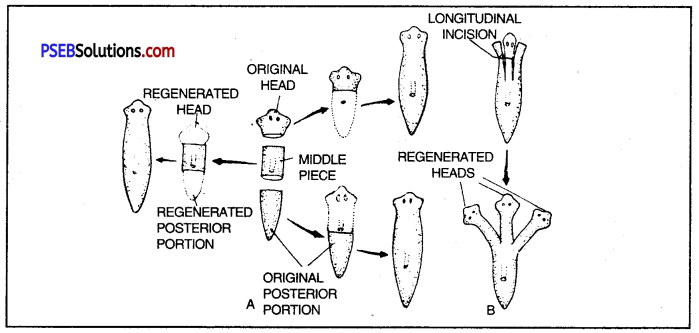
Regeneration in planarians. A. Three individuals regenerate from an individual cut into three parts. B. Formation of a heteromorph with three heads.
![]()
Question 9.
What is vegetative propagation?
Answer:
Vegetative Propagation: Vegetative propagation is defined as formation of two or more individuals from any vegetative part of plant. In this type of vegetative propagation new plants can be raised from roots or stems or leaves of a plant.
It is a very rapid method. It is of two types.
- Natural vegetative propagation
- Artificial vegetative propagation.
Question 10.
Explain natural vegetative propagation by roots in plants.
Answer:
A number of herbaceous and woody perennial plants propagate vegetatively in nature. The common structures that take part in natural vegetative propagation are roots, stems, leaves and buds.
Vegetative Propagation by Roots:
Roots of some plants like radish, carrot, asparagus, tapioca, Dahlia and sweet potato etc. are tuberous and store abundant food material.
These roots when planted in specially prepared beds (soil), develop adventitious buds which grow into leafy shoots called “slips”. As the root tubers in sweet potato store large amounts of food, each produces several “slips”. The young “slips”are detached from the parent plant and grown separately.
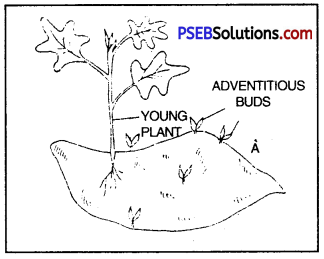
Vegetative propagation by roots is sweet potato
Question 11.
Briefly explain vegetative propagation by stems.
Answer:
Vegetative propagative by stems:
All underground stems even some aerial stems help in vegetative propagation. Some of these are aerial and creeping e.g. runners (Cynodon dactylon, lawn grass), stolons (Fragaria vesica, strawberry), and offsets (Eichhornia); other are underground e.g. rhizomes (Zingiber officinale), corms (Coloccisia), bulbs {Allium, cepa) and tubers (Solanum tuberosum).
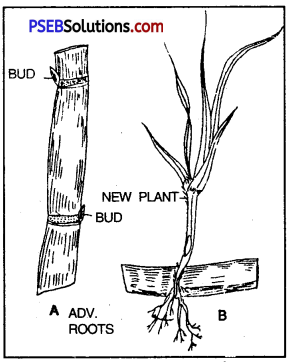
Propagation of sugar cane from section of aerial stem. A, a piece of sugarcane stem having buds; B, bud growing into a new plant
Aerial stems of sugarcane, ipomoea, grape vine and cacti are also used for vegetative propagation.
In sugarcane, portions of the stem bearing one or more nodes and buds are cut and planted in the soil. Adventitious roots develop from the nodes and the buds grow into aerial shoots.
Question 12.
Give a brief account of vegetative propagation in leaves.
Or
Illustrate the following with the help of suitable diagram :
Leaf of BryophyHum with buds.
Answer:
Vegetative Propagation by Leaves. Under suitable conditions new plants can develop from the leaves.
In Bryophyllum, leaf helps in vegetative propagation. In the leaf there are notches, where meristem is present. When leaf comes in contact with soil, this meristem produces a new plant. Adventitious buds are formed in Begonia and Lilium on leaves which too help in vegetative propagation.
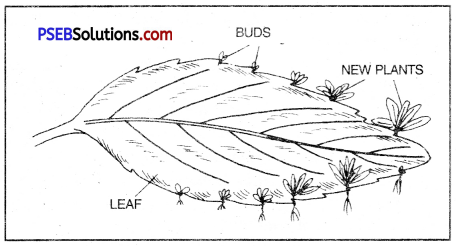
Vegetative propagation by leaves in Bryophyllum
Question 13.
Differentiate grafting and cutting.
Answer:
Differences between grafting and cutting
| Grafting | Cutting |
| 1. The process of fixing the stem piece on another stem fixed to the soil is called grafting. | 1. The use of piece or cutting and placing it in moist soil is called cutting. |
| 2. It involves stem pieces of two plants. | 2. Only single plant is used. |
| 3. The stem fixed to soil is called stock and grafted part is scion. | 3. The pieces used are called cutting. |
Question 14.
What is the difference between cutting and layering?
Answer:
Difference between cutting and layering
| Cutting | Layering |
| 1. The piece of plant called cutting is placed in soil. | 1. The branch from intact plant is kept in moist soil. |
| 2. It is carried out by using root, stem and leaf. | 2. Soft stem is used for layering |
Question 15.
Explain tissue culture.
Answer:
Tissue culture: In this method, tissue or organ culture is utilized. Tissue or organ is grown on suitable medium containing hormones. Tissue proliferates to form, callus. From this callus arise new plantlets. Each plantlet when transferred to pot or soil produces new plant. Thus by this method, an indefinite number of plants can be raised from a small mass of parental tissue. This technique is commonly used for ornamental plants.
![]()
Question 16.
Write merits of vegetative propagation.
Answer:
Merits of vegetative propagation
Vegetative propagation has outstanding advantages. Some of these are as follows :
- Plants produced by vegetative propagation are genetically similar and constitute a uniform population known as clone.
- Some fruit trees like banana, pine-apple do not produce viable seeds so these are propagated by only vegetative methods.
- It is more rapid and easier method of propagation.
- Good characters are preserved by vegetative propagation.
- Most of the ornamental plants are propagated by vegetative propagation.
Question 17.
Write demerits of vegetative propagation.
Answer:
Demerits of vegetative propagation
- New varieties cannot be produced by vegetative propagation.
- Quality of fruits cannot be changed since there is no sexual fusion, no meiosis and no recombination of characters occur.
- Weeds growing with plants is harmful as there occurs widespread of weeds.
- Disease contacted by a parent plant propagates in all the daughter plants.
- There are no special mechanisms for dispersal.
Question 18.
What is a flower? Define the unisexual and bisexual giving one example of each.
Answer:
A flower is a specialized shoot which shows a limited growth and bears organs (stamens and pistils) essential for seed and fruit formation.
- Unisexual Organism. Male and female sex organs are present in different individuals.
Example : Human - Bisexual organism. Single individual having both male and female sex organs.
Examples : Most of the plants, Tapeworm, Earthworm.
Question 19.
What is placentation?
Answer:
Placentation: The ovary contains one or more ovules, which later become seeds. The ovule bearing region of the carpel is called placenta. The arrangement of placentae and ovules within the ovary is called placentation.
Question 20.
What is pollination?
Answer:
Pollination. It is the transference of pollen grains from the anther of a flower to the stigma of the same or different flower.
Question 21.
What are the ways in which pollination occurs?
Answer:
Pollination may occur in any of the following ways :
- The pollen of the same flower may fall on its stigma by itself.
- The pollen of another flower of the same plant may fall on the stigma.
- The pollen of a flower of another plant of the same species may land on the stigma.
- This transference can occur through wind, insects or other agents.
Question 22.
What are the two kinds of pollination?
Answer:
Kinds of pollination.
- Self-pollination. It is the transfer of pollen from the anther to the stigma of the same flower or to the stigma of another flower of the same plant.
- Cross-pollination. It is the transfer of pollen from the anthers of flowers of one plant to the stigma of a flower of another plant.
Question 23.
Write two differences between self-pollination and cross-pollination.
Answer:
Differences between Self-pollination and Cross-pollination
| Self-pollination | Cross-pollination |
| 1. It occurs within a flower or between two flowers of the same plant. | 1. It occurs between two flowers borne on different plants of the same species. |
| 2. Flowers do not depend upon other agencies for pollination. | 2. Agents such as insects, water and wind are required ensuring pollination. |
Question 24.
Draw well-labelled diagram of V.S. of the mature ovule of Angiosperms.
Answer:
Mature ovule.
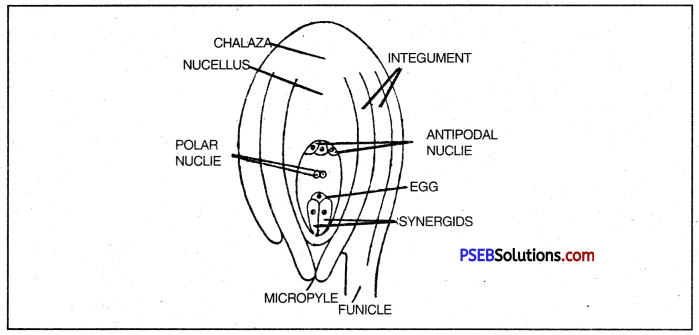
V.S. of mature ovule to show various parts
Question 25.
Give the structure of pollen grain.
Answer:
Structure of Pollen Grain
Pollen grain is a microscopic unicellular structure. It is covered by two layered walls— the inner intine and the outer thick exine. At certain places the exine has pores called germ pores. It contains two nuclei — a generative nucleus and a tube nucleus.
![]()
Question 26.
Trace the steps involved in the formation of the plant seed from pollination.
Or
Explain sexual reproduction in flowering plants.
Answer:
Formation of plant seed
- Pollination is transfer and deposition of pollen on stigma.
- Pollen grain germinates on the stigma. It gives rise pollen tube which carries male gametes.
- A hypodermal cell of the nucellus in ovule enlarge’ cod forms megaspore mother cell.
- The diploid megaspore mother cell undergoes meiosis to form four megaspores.
- The functional megaspore enlarges into embryo sac.
- The process of nuclear fusion (syngamy) of the male nucleus and one egg nucleus is termed fertilization. It forms diploid zygote. Second male gamete fuses with secondary nucleus to form primary endosperm nucleus.
- Angiosperms exhibit double fertilization.
- Fall of the petals, stamens, style and stigma.
- The ovules develop into seeds.
- As seeds contain the miniature but dormant future plant, they are dispersed by various agents such as wind, water and animals.
Question 27.
Depict the events of fertilization.
Answer:
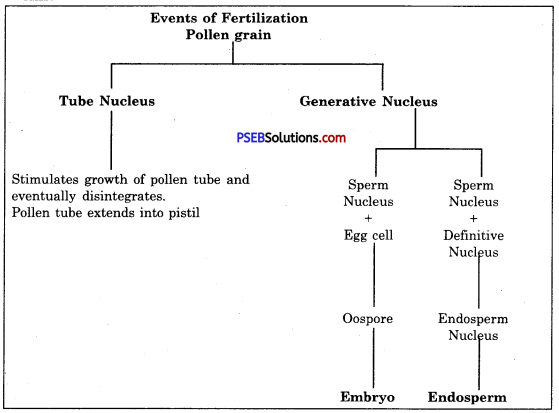
Question 28.
With the help of a labelled diagram, describe double fertilisation in plants.
Answer:
Double fertilization in plants:
- The process of double fertilization occurs inside each embryo sac in which two fusions i.e. syngamy and triple fusion takes place.
- As the pollen tube enters the ovule, the pollen tube releases two male gametes into
embryo sac. - The embryo sac contains the egg.
- The fusion of male and female gametes in the embryo sac of ovule is called syngamy. The product is called zygote.
- The other male gamete fuses with the two polar nuclei. It is called triple fusion.
Significance:
- Double fertilization provides stimulus to endosperm mother cell for the formation of nutritive tissue named endosperm.
- It ensures continued supply of nourishment to the embryo that develops from zygote.
Question 29.
Draw diagram to show the path of pollen tube into pistil during fertilization.
Answer:
Path of Pollen tube into pistil during fertilization
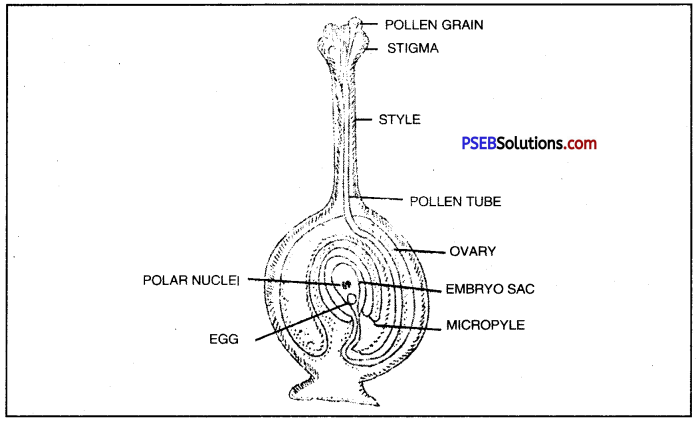
Path of pollen tube in the pistil
Question 30.
Explain post-fertilization changes in plants.
Answer:
Post-fertilization changes. After fertilization most of the parts of the flower wither and significant changes occur inside the ovary.
- The fertilized egg or zygote (oospore) along with the ovule changes into the seed.
- The wall of the ovule forms the seed coat (testa). The seed contains the potential plant or embryo.
- The embryo consists of radicle (potential root), plumule (potential shoot) and cotyledons (seed leaves).
- In dicotyledonous plants there are two cotyledons while in monocotyledonous plants there is only one cotyledon.
- In monocotyledonous plants food is stored in the endosperm (part of the seed).
- The seeds become dry and dormant to overcome adverse conditions.
- Ultimately the wall of the ovary ripens and changes into a fruit. Thus we see the seeds inside the fruit.
Question 31.
Name the various organs of male reproductive system of man.
Answer:
Male reproductive organs of man
- A pair of testis
- A pair of epididymis
- A pair of vasa deferentia
- Urethra
- Penis
- A pair of emina1 vesicles.
- Male reproductive glands, Cowper’s gland and prostate gland.
Question 32.
Name the various organs of female reproductive system.
Answer:
Female reproductive system is composed of following organs :
- A pair of ovaries.
- A pair of fallopian tubes.
- Uterus
- Vagina
- Vulva.
![]()
Question 33.
What are the male and female gonads in human beings? Mention their function.
Answer:
Male Gonads: The male gonads are called testes and female gonads ovaries.
Functions of testes :
- Testes produce male gametes called sperms.
- Testes produce male sex hormone called testosterone.
Functions of ovary :
- Formation of female gametes (ova).
- Production of female sex hormones (Estrogen and progesterone).
Question 34.
(a) In the human body what is the role of
(i) seminal vesicles and
Answer:
Function of seminal vesicles.
They secrete viscous alkaline seminal fluid that contains sugar fructose and ascorbic acid. Fructose provide energy to the spermatozoa for swimming.
(ii) prostate gland?
Answer:
Functions of prostate gland
- It secretes the milky white slightly acidic fluid.
- The secretion nourishes and serves as the medium for spermatozoa.
(b) List two functions performed by testes in human beings.
Answer:
Functions of testes :
- Testes produce male gametes called sperms.
- Testes produce male sex hormone called testosterone.
Question 34.
Write names of one male and one female sex hormones.
Answer:
- Male sex hormones. Testosterone.
- Female sex hormone. Estrogen.
Question 35.
Define Menstruation, precocious puberty and menopause.
Answer:
Menstruation: It is a process in which the blood, mucus and uterine tissue is eliminated in female mammals.
Precocious puberty: Normally a woman’s fertile life starts from the age of puberty (about 13 years), but under some abnormal conditions like high level of sex hormones (LH and FSH), menstruation starts at an early age than the normal, and then it is called precocious puberty.
Menopause: The natural physiological stoppage of menstruation is called menopause or the arrest of reproductive capacity at the age of 45-50 is called menopause. Woman is unable to bear the children at this stage.
Question 36.
Name and define the four stages in the uterine cycle.
Answer:
Uterine Cycle: The uterine cycle consists of four distinct stages as follows :
- Menstruation. It lasts for five to seven days.
- The proliferative phase. From the end of menstruation to the release of ovum, it lasts for 10-14 days.
- Ovulatory phase. It is the release of ovum from the ovary.
- Luteal. It lasts from ovulation to menstruation for about 10-days.
Question 37.
Write a short note on child birth or parturition.
Answer:
- At or about the 40th week of pregnancy labour sets in. Contraction of the muscles of the uterine wall starts in the early stages of labour. This results in severe pain to the mother. It is known as labour pain.
- The contraction of the uterine wall brings the baby towards the mouth of the uterus.
- The joint of the pelvic bones becomes more flexible.
- The cervix and the vaginal passage becomes much more flexible and wider.
- At the same time, the uterine contractions become more and more forceful due to which the baby is forced out more and more.
- Finally, it comes out completely. Generally the head comes out first followed by the shoulders, then the body and finally the legs.
Question 38.
What is placenta?
Answer:
Placenta: It is the structure formed by the union of the foetal and uterine tissue for the purpose of nutrition, respiration and excretion of the embryo. Although the blood vessels of the embryo and the mother come close but these are kept separated by some barriers between them. The useful substances pass from maternal blood to foetal blood while the wastes (excretory products and C02) are passed from the foetal blood to maternal blood.
Question 39.
Write the functions of placenta.
Answer:
Functions of placenta: The placenta serves primarily as an organ that permits the interchange of materials carried in the blood of mother and foetus.
The main functions are :
- Nutrition: Supply of nutrient materials to foetus.
- Respiration: Supply of 02 to foetus and receive C02 back from it.
- Excretion: Fluid nitrogenous waste products escape through the placenta.
- Barrier: The placenta is barrier like semipermeable membrane.
- Storage: The placenta stores fat, glycogen and iron for the embiyo before the formation of liver.
- Hormonal function: The placenta secures extra ovarian hormones estrogen and progesterone in female during pregnancy that serves to maintain foetus.
Question 40.
What is artificial insemination? Write the uses of artificial insemination.
Answer:
Artificial insemination: A process by which spermatozoa are collected from male and deposited in the female genitalia by instrumentation rather than by natural service is called artificial insemination.
Uses of artificial insemination
- The semen of good quality of male animal may be used to inseminate number of females.
- The preserved spermatic fluid can be transported to different places.
- In case of man who is incapable of producing children this method can be used.
Question 41.
Name one sexually transmitted disease each caused due to bacterial infection and viral infection. How can these be prevented?
Answer:
- Sexually transmitted disease caused due to bacterial infection : Syphilis.
- Sexually transmitted disease caused due to viral infection : AIDS.
Prevention of sexually transmitted disease
- People, particularly those in high-risk group, should be educated about AIDS transmission, advantage of using condom, danger of sharing needles and virtue of monogamy. Adultery has been prohibited in all religions. It must be avoided.
- Sexual habits should be changed.
- Before receiving blood, it should be screened for HIV.
Question 42.
What is puberty? Name the hormones responsible for production of sexual characters in human beings.
Answer:
Puberty: The period at which reproductive organs become mature and capable of functioning.
1. Changes in female (girl) at the time of puberty. These changes occur under the influence of hormones FSH (Follicle stimulating hormone) and estrogen.
- Growth of breast and external genitalia.
- Darkening of nipple skin.
- Broadening of pelvis.
- Growth of pubic and axillary hair.
- Increase in subcutaneous fat.
- Initiation of menstruation and ovulation.
2. Changes in male (boy): In male testosterone hormone is responsible for puberty.
- Change of voice.
- The appearance of beard and moustaches.
- Discharge of semen.
![]()
Question 43.
Label the parts of human male reproductive system.
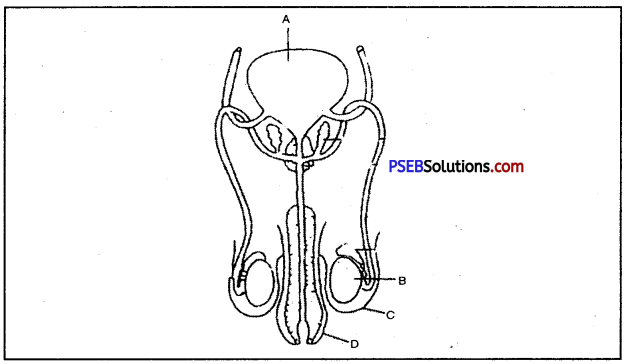
Answer:
- A – Bladder
- B – Testis
- C – Scrotum
- D – Penis.
Very Short Answer Type Questions
Question 1.
Why do organism reproduce?
Answer:
Organisms reproduce so that species may continue.
Question 2.
Where are gene present?
Answer:
Genes are present in nucleus of cell.
Question 3.
Name the molecules which carry genetic information.
Answer:
DNA.
Question 4.
Expand DNA.
Answer:
DeoxyRibose Nucleic Acid.
Question 5.
DNA contains information for the synthesis of which molecule?
Answer:
Protein synthesis.
Question 6.
Name the molecules which makes its copy before reproduction.
Answer:
DNA.
Question 7.
What is the basis for evolution?
Answer:
The inbuilt capacity for variations during reproduction.
Question 8.
What is the role of reproduction?
Answer:
- Propagation of species
- Evolution of species.
Question 9.
Why are variation useful for organism?
Answer:
Variation enables the organism for its survival.
![]()
Question 10.
Name the various methods of vegetative propagation in plants.
Answer:
- Cutting
- Layering
- Grafting.
Question 11.
Which part of bryophyllum can be used for vegetative propagation?
Answer:
Leaf of Bryophyllum.
Question 12.
Give one example of each: Vegetative propagation by (i) root (ii) stem.
Answer:
- Vegetative propagation by roots e.g. Sweet potato
- Vegetative propagation by stem e.g. Potato.
Question 13.
(i) When does binary fission and multiple fission in amoeba take place?
Answer:
Binary fission takes place during favourable period and multiple fission occurs during unfavourable period in amoeba.
(ii) ‘Malarial parasite’ divides into many daughter individuals simul-taneously through multiple fission. State an advantage the parasite gets because of this type of reproduction.
Answer:
Multiplication i.e. increase in number.
Question 14.
How do yeast, sponges and hydra reproduce asexually?
Answer:
All the three reproduce by budding.
Question 15.
How do Spirogyra and Mucor reproduce asexually?
Answer:
Spirogyra. Fragmentation and Regeneration, Mucor. Spore formation.
Question 16.
Which kind of organism have complex mode of reproduction.?
Answer:
Multicellular orsganisms.
Question 17.
Give two examples which reproduce as a result of reproduction.
Answer:
Hydra and Planaria.
Question 18.
Which part of cell is used for tissue culture technique?
Answer:
Tissue or cells from the tip of shoot are used for obtaining plants by tissue culture method.
Question 19.
What is callus?
Answer:
An unorganised mass of cells formed by repeated cell division in tissue culture technique.
Question 20.
What are the fibrous growth present on bread?
Answer:
Hyphae of rhizopus (A fungus)
Question 21.
What is sperm?
Answer:
Motile male gamete is called sperm.
Question 22.
What is ovum?
Answer:
Female gamete is called ovum. It is non-motile ooplasm rich in nutrients.
Question 23.
Name the male and female reproductive organs of a flower.
Answer:
Male organs Stamen, Female organ-Carpel (Pistil).
Question 24.
Name two plants which bear unisexual flowers.
Answer:
Papaya, Water melon.
Question 25.
Give two example of plants which bear bisexual flowers.
Answer:
Mustard plant, Rose plant.
Question 26.
Name the agencies which help in pollination.
Answer:
Air, water, insects and other animals.
Question 27.
Name the hormone which play role in formation of sperm.
Answer:
FSH (Follicle Stimulating Hormone)
Question 28.
When and where are eggs formed in females?
Answer:
Eggs are formed in ovarian follicles of ovary during foetal condition.
Question 29.
Where is fertilized egg implanted after fertilization?
Answer:
Uterus.
Question 30.
Coin the term for fusion of male and female gametes.
Answer:
Fertilization.
Question 31.
Give examples of plants which are propagated by stem cutting.
Answer:
Sugarcane, Rose, Fig and Mulberry.
Question 32.
Name plants .which reproduce by artificial vegetative propagation.
Answer:
Grapes, Rose and Fig.
Question 33.
Name three methods of vege-tative propagation,
Answer:
- Cutting
- Grafting
- Layering.
Question 34.
Give two examples of each. Vegetative propagation by
(i) Tissue culture
Answer:
Tissue culture – Orchid, Asparagus
(ii) Layering.
Answer:
Layering – Magnolis, Rhododendson
Question 35.
What term is used if the pollen is transferred to the stigma of same flower?
Answer:
Self-pollination.
Question 36.
What is fruit?
Answer:
Fruit: Fruit is a ripened ovary.
Question 37.
Which parts of the seed form root and shoot?
Answer:
- Root is formed from radicle.
- Shoot is formed from plumule.
Question 38.
What are the advantages of vegetative propagation?
Answer:
- Plants produced are genetically similar and form uniform population.
- It is a rapid method of propagation.
Question 39.
Name four methods of asexual repoduction.
Answer:
- Binary fission
- Multiple fission
- Budding
- Fragmentation
![]()
Question 40.
Name three plants which repor-duce by natural vegetative methods.
Answer:
- Potato
- Banana
- Sweet potato.
Question 41.
What is a flower?
Answer:
Flower: It is a modified shoot specialized to carry out sexual reproduction in plants.
Question 42.
Name four whorls of flower.
Answer:
Whorls of flower:
- Calyx
- Corolla
- Androecium and
- Gynoecium.
Question 43.
List the different parts of a carpel.
Answer:
Carpel: It consists of three parts, viz., ovary, style and stigma.
Question 44.
Where are pollens and ovules present in flower?
Answer:
- Pollens – Anther lobes
- Ovules – Ovary.
Question 45.
What is pollination?
Answer:
It is the transference of pollen grains from anthers of a flower to the stigma of same or another flower of same species.
Question 46.
What is formed in the egg after fertilization?
Answer:
Embryo.
Question 47.
Give example for asexual method of resproduction.
Answer:
Hydra.
Question 48.
What will happen if hydra is cut into two or more pieces?
Answer:
Each piece of hydra will grow into new individuals and the process is called regeneration.
Question 49.
What is gamete?
Answer:
Gametes are male and female sex cells.
Question 50.
Coin the term for male and female gamete.
Answer:
Sperm and ovum respectively.
Question 51.
Give two examples of bisexual animals.
Answer:
- Liver fluke
- Earthworm.
Question 52.
What is fertilization?
Answer:
Fusion of male and female gametes is called fertilization.
Question 53.
What are viviparous animals?
Answer:
The animals which give birth to young ones are called viviparous animals.
Question 54.
What are oviparous animals?
Answer:
The animals which lay eggs are called oviparous animals.
Question 55.
Give examples of vivi-parous animals?
Answer:
- Cow
- Cat
- Monkey.
Question 56.
Write examples of oviparous animals.
Answer:
- Insects
- Frog
- Birds.
Question 57.
Name two types of pollination.
Answer:
- Self-pollination
- Cross-pollination.
Question 58.
Name three parts of pistil.
Answer:
- Ovary
- Style
- Stigma.
Question 59.
What is foetus?
Answer:
A 12 week old embryo in the genital tract (uterus) of mother in viviparous animals is called foetus.
Question 60.
List two characters which start developing in girls during puberty.
Answer:
- Growth of mammary glands.
- Growth of public hairs.
Question 61.
State any two characters which appear during.puberty in boys.
Answer:
- Appearance of beard.
- Growth of public hairs.
Question 62.
What is semen?
Answer:
Sperms and seminal plasma constitute semen.
Question 63.
What is placenta?
Answer:
Placenta is an organ of attachment between an embryo and the uterine wall of mother w hich is for med jointly by them.
Question 64.
Define pregnancy.
Answer:
The duration for whic h embryo remain implanted inibhe wall of uterus is called pregnancy or period of gestation.
Question 65.
Name the organs of human male reproductive system.
Answer:
- 1. Testes
- Scrotum
- Epididymes
- Vasa deferntiai
- Urethra
- Reproductive glands (seminal vesicles prostate gland and and Cowper’s glands).
![]()
Question 66.
Name the organs of human female reproductive system.
Answer:
- Ovariea
- Oviducts (Fallopian tubes)
- Uterus
- Vagina
- Vulva
- Female reproduct ive glands (Mammary glands).
Question 67.
What is ovulation?
Answer:
Ovulation is release of mature ovum by bursting the mature follicle of ovary.
Question 68.
Supply the scientific term for the following :
(i) Release of ovum from ovary.
Answer:
Ovulation
(ii) Onset of menstrual cycle in female.
Answer:
Puberty.
Question 69.
What is the function of sperm duct?
Answer:
Sperm duct (vas deferens). It conducts sperms from testes to urethra.
Question 70.
What is the function of scrotum?
Answer:
Thermoregulation. Scrotum provides a lower temperature than body temperature for the development of sperms.
Question 71.
Give two examples of accessory sex characters in man.
Answer:
Accessory sex characters :
- Presence of facial hair in man.
- Broad shoulders and low pitch voice.
Question 72.
What is after birth?
Answer:
Placenta expelled after delivery.
Question 73.
What will happen if the fallopian tubes are partially blocked and the ovulated eggs are prevented from reaching the uterus?
Answer:
Fertilization may take place but the zygote may develop in the tube instead of uterus.
Question 74.
Where does fertilization take place in human beings?
Answer:
In the fallopian tube.
Question 75.
How does the developing child itt the uterus get its nourishment?
Answer:
It gets its nourishment from placenta.
Question 76.
In how many weeks develop-ment of foetus is completed?
Answer:
About 40 (forty) weeks after fertilization.
Question 77.
Give one example of each, (i) mechanical methods of contra-ception (ii) chemical methods of contra-ception.
Answer:
Mechanical. Condoms in males and diaphragm in female.
Chemical. Use of oral pills.
Question 78.
What is the removal of small piece of sperm duct from male and fallopian tube from female called?
Answer:
Removal of sperm duct – Vasectomy
Removal of fallopian tube – Tubectomy.
Question 79.
When do the boys attain adolescence?
Answer:
16 to 18 years.
Question 80.
When do the girls attain adole-scence?
Answer:
13 to 15 years.
Question 81.
Name the part of female genital tract where foetus develops.
Answer:
Uterus.
Question 82.
What is the function of copper-T?
Answer:
A copper-T is placed safely inside the uterus. It prevents implantation in the uterus.
Question 83.
List the aspects which reproductive health includes.
Answer:
Reproductive health includes aspects that ensure a responsible, safe and satisfying reproductive life.
Question 84.
Name any three sexually transmitted diseases (STDs).
Answer:
Gonorrhoea, Syphilis and AIDS.
Multiple Choice Questions
Question 1.
Reproduction in Amoeba is by:
(A) Binary fission
(B) Multiple fission
(C) Budding
(D) Regeneration.
Answer:
(A) Binary fïssion
![]()
Question 2.
Biyophyllum in nature is reproduced by :
(A) Foliar adventitious buds
(B) Seeds
(C) Roots
(D) None of these.
Answer:
(A) Foliar adventitious buds
Question 3.
In which organism can we see budding?
(A) BrvophyHurn
(B) Hydra
C) Yeast
(D) All of above.
Answer:
(B) Hydra
Question 4.
In which of the following regeneration take place?
(A) Hydra
(B) Planaria
(C) Both A & B
(D) Human.
Answer:
(D) Human.
Question 5.
In which of the following asexual reproduction take place through spore formation?
(A) Plasmodium
(B) Leishmania
(C) Spirogvra
(D) Rhizopus.
Answer:
(D) Rhizopus.
Question 6.
In man why testes are located outside the abdominal cavity in scrotum?
(A) For security reasons
(B) Because sperms formation needs lower temperature than normal body temperature
(C) For proper delivery of sperms to the female vaginal tract during copulation
(D) None of the above.
Answer:
(B) Because sperms formation needs lower temperature than normal body temperature
Question 7.
If the egg is not fertilized then lining of which of the following breaks and come out as blood?
(A) Cervix
(B) Oviduct
(C) Vagina
(D) None of these.
Answer:
(D) None of these.
Question 8.
Which of the following shrivel and fall off when ovary risens to form fruit :
(A) Sepals
(B) Petals
(C) Stamen
(D) All of the above.
Answer:
(D) All of the above.
Question 9.
Placenta is embedded in:
(A) Cervix
(B) Uterus
(C) Vagina
(D) Oviduct.
Answer:
(B) Uterus
Fill in the blanks:
Question 1.
________ is a means of perpetuation of the species.
Answer:
Reproduction.
![]()
Question 2.
________ are well defined places of population of organism of any ecosystem.
Answer:
Niches.
Question 3.
________ and ________ are common methods of reproduction.
Answer:
Fission and Budding.
Question 4.
________ is a reproductive shoot of higher plants.
Answer:
Flower.
Question 5.
________ is the process of fusion of male gamete with egg or oosphere.
Answer:
Fertilization.
Question 6.
Fertilization occurs in ________
Answer:
Fallopian tubes.
Question 7.
________ occurs in angiospermic plants.
Answer: